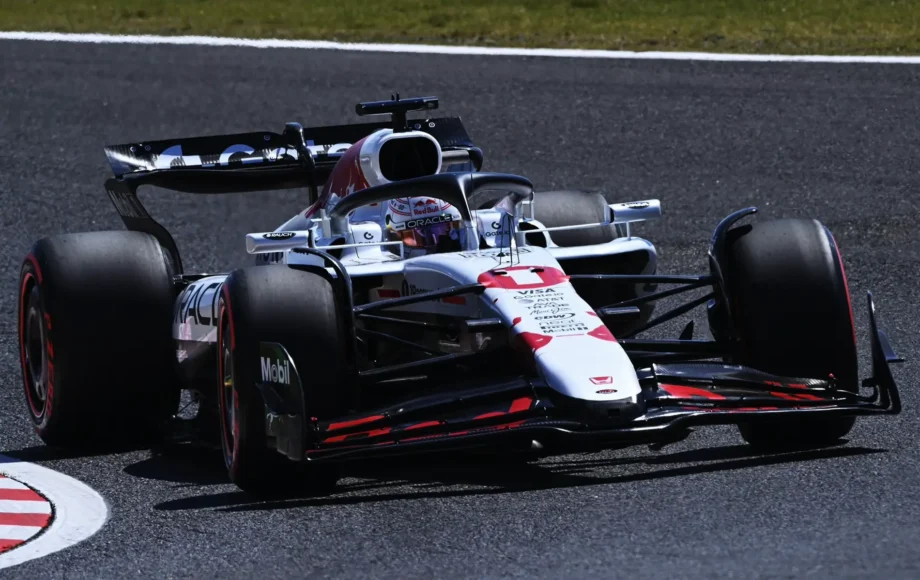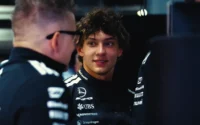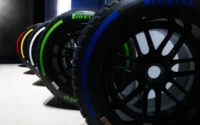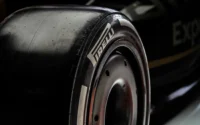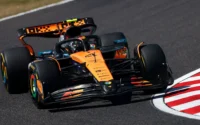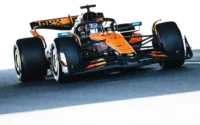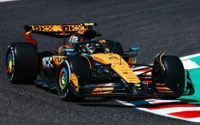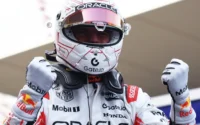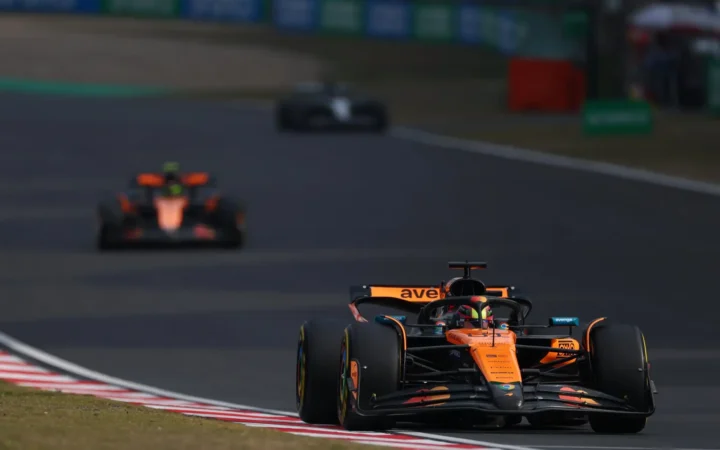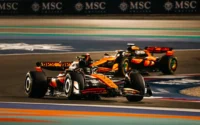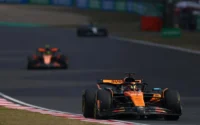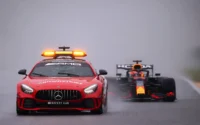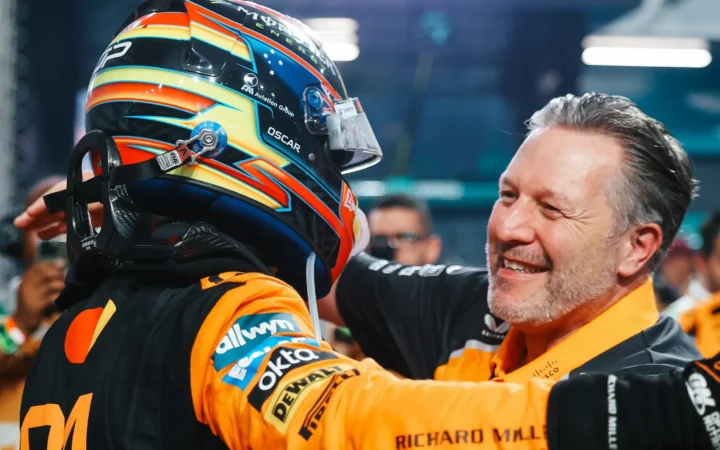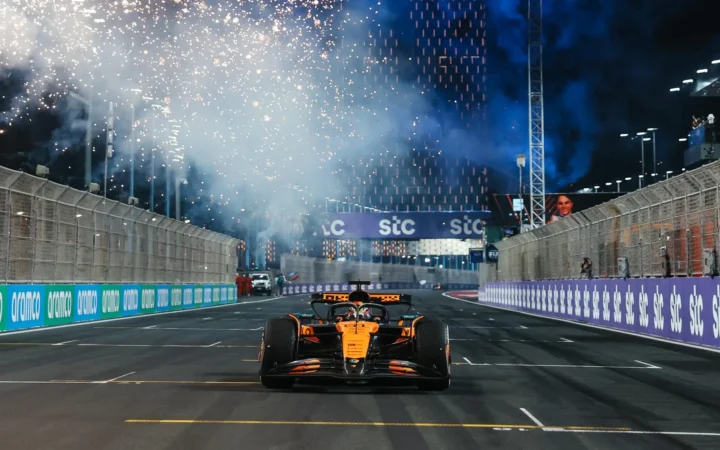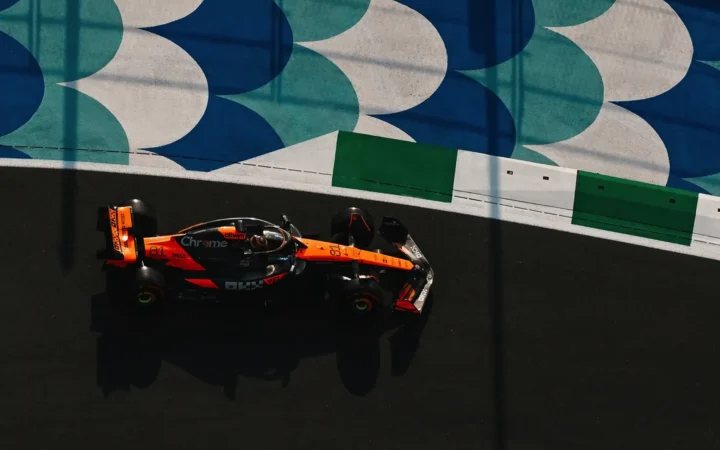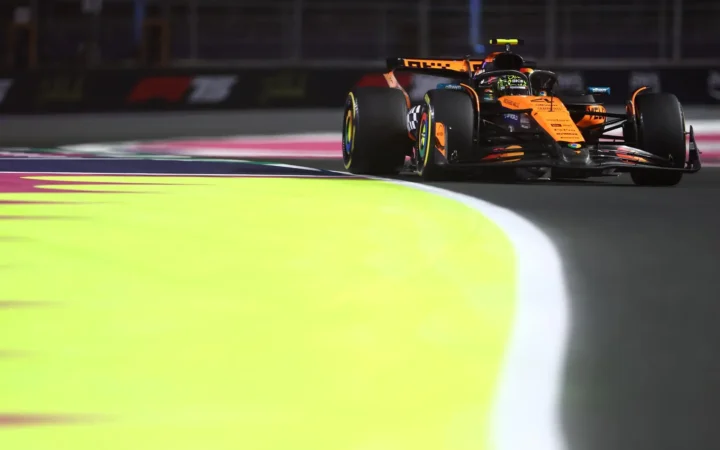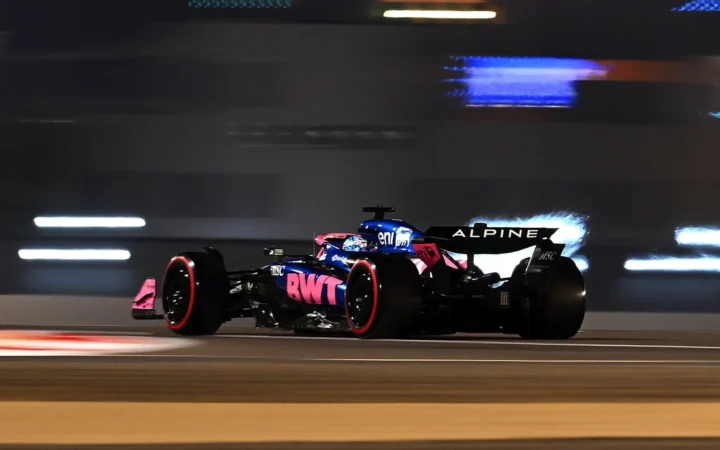The 2025 season was only two races old, but it had already delivered the kind of drama and unpredictability fans live for—multiple winners, big headlines, and a dose of controversy. Now, the campaign kicked into higher gear with the first triple-header of the year, beginning at one of Formula 1’s crown jewels: Suzuka. A favourite among drivers and fans, the Japanese Grand Prix was round three, setting the stage for a high-stakes weekend before the paddock jetted off to Bahrain and Saudi Arabia in the following weeks.
Known for its flowing, high-speed corners and relentless technical demands, Suzuka is a true test of driver skill. But this year, the iconic circuit had an extra buzz in the air. The ever-passionate Japanese fans would be out in force with even more to cheer for, as Yuki Tsunoda stepped into the spotlight with a shock promotion to the main Red Bull team—displacing Liam Lawson after just two rounds. With national pride and major championship momentum on the line, the 2025 season was already shaping up to be unforgettable.
Race Guide
Season: 2025 F1 World Championship
Race weekend: 4 April 2025 – 6 April 2025
Race date: Sunday, 6 April, 2025
Race start time: 14:00 local time
Circuit: Suzuka International Racing Course
Laps: 53
Circuit length: 5.807km
2024 winner: Max Verstappen
| Pole position | |||
|---|---|---|---|
| Driver | Max Verstappen | Red Bull Racing | |
| Time | 1:26.983 | ||
| Fastest lap | |||
| Driver | Kimi Antonelli | Mercedes | |
| Time | 1:30.965 on lap 50 | ||
| Podium | |||
| First | Max Verstappen | Red Bull Racing | |
| Second | Lando Norris | McLaren | |
| Third | Oscar Piastri | McLaren | |
There are few places in Formula 1 as iconic or steeped in F1 History as Suzuka. Winding through 3.6 miles (5.807km) of fast, flowing tarmac, the legendary Japanese circuit has tested the world’s best drivers and cars since its debut in 1987. Famous for its unique figure-of-eight layout—the only one of its kind on the calendar—Suzuka serves up an unforgettable mix of corners, from the snaking Esses in the first sector to the punishing Degners, the looping Spoon Curve, and the flat-out blast through 130R. It’s a circuit that commands respect and precision, a place where titles have been won and lost—most famously in the fierce duels between Ayrton Senna and Alain Prost.
Historically a late-season race and the site of championship showdowns, Suzuka now holds an earlier slot on the calendar since 2024, arriving during Japan’s beautiful cherry blossom season. The picturesque setting adds a touch of serenity to a race weekend that’s anything but, with the technical demands of the circuit offering no margin for error. The track remains largely unchanged over the years, a testament to its near-perfect original design, though there have been a few subtle modifications for 2025. Kerbs and run-off areas have been tweaked, most notably at Turn 9 where a single kerb has been replaced by a higher double kerb, and synthetic grass at several corners has been swapped for gravel to increase the penalty for running wide.
Before the 2025 race, 40 F1 World Championship races had been held on Japanese soil since the country’s debut in 1976. While Suzuka is the most famous and frequently used venue, three different circuits have hosted the Japanese rounds over the years. The Aida circuit was home to the Pacific Grand Prix in 1994 and 1995, while Fuji Speedway staged the Japanese Grand Prix in 1976, 1977, 2007, and 2008. The remaining 34 editions of the Japanese Grand Prix have been run at Suzuka, starting from its inaugural race there in 1987.
Statistically, before the 2025 race, no driver has dominated in Japan quite like Michael Schumacher. The seven-time world champion notched six victories at Suzuka—one with Benetton and five with Ferrari—and also claimed both Pacific Grand Prix wins at Aida. Lewis Hamilton, who shared Schumacher’s tally of world titles, sat second on the all-time Japan win list with five—one at Fuji and four at Suzuka. Among constructors, McLaren led the pack with nine victories in Japan, while Ferrari and Red Bull were tied for second with seven apiece. Schumacher also held the record for most pole positions in the country with eight, and Ferrari led in team poles with ten.
Japan held a unique position for decades as the scene of championship glory. Until its calendar shift in 2024, the Japanese Grand Prix was instrumental in crowning F1 champions—14 titles were decided on its tracks. Suzuka saw Ayrton Senna clinch all three of his world championships (1988, 1990, and 1991), while Schumacher sealed two titles there (2000 and 2003) and another in Aida (1995). Mika Hakkinen claimed both his titles at Suzuka in 1998 and 1999. Other drivers to secure championships on Japanese soil include James Hunt (1976), Nelson Piquet (1987), Alain Prost (1989), Damon Hill (1996), Sebastian Vettel (2011), and Max Verstappen in 2022.
Weekend schedule
| Date | Session | Local Time |
|---|---|---|
| 4 April 2025 | Free Practice 1 (FP1) | 11:30 am – 12:30 pm local time |
| 4 April 2025 | Free Practice 2 (FP2) | 3:00 pm – 4:00 pm local time |
| 5 April 2025 | Free Practice 3 (FP3) | 11:30 am – 12:30 pm local time |
| 5 April 2025 | Qualifying | 3:00 pm – 4:00 pm local time |
| 6 April 2025 | Race | 2:00 pm local time |
Saturday qualifying brought a dramatic late twist when Max Verstappen stole pole position from McLaren at Suzuka with a blistering 1:26.983 lap, edging out Lando Norris and Oscar Piastri by mere hundredths. While McLaren had dominated the early sessions, Verstappen’s final effort shocked the paddock and secured his fourth consecutive Japanese GP pole. Rookies Hadjar, Bearman, and Antonelli starred in a session packed with surprises and razor-thin margins.
Come Sunday, Max Verstappen claimed his first win of the 2025 season with a composed drive at Suzuka, holding off McLaren’s Lando Norris and Oscar Piastri in a tense and tactical Japanese Grand Prix. The decisive moment came during the pit stops, where a near clash at pit exit saw Norris forced onto the grass as Verstappen rejoined ahead—an incident deemed a racing matter by stewards. Despite late pressure from both McLarens, Verstappen controlled the race to secure his fourth straight Suzuka victory and 64th career win, closing to within one point of Norris in the championship. Piastri completed the podium, with Leclerc, Russell, Antonelli, and Hamilton rounding out the top seven, while rookie Isack Hadjar scored his first F1 points in eighth. Yuki Tsunoda finished 12th on his Red Bull debut, earning Driver of the Day honours from the fans.
Formula One History Recommends
Championship background
Red Bull made headlines a week before the race with a bold move just two races into the 2025 season, promoting Yuki Tsunoda to the senior team alongside Max Verstappen and sending Liam Lawson back to Racing Bulls. The decision sent shockwaves through the paddock—not just for its swiftness, but for its timing ahead of Tsunoda’s home Grand Prix at Suzuka, instantly raising the stakes for what was already shaping up to be a high-profile weekend for Tsunoda and the Honda-powered Red Bull sister teams.
Tsunoda’s promotion arrived in his fifth season in Formula 1, and many would say it had been a long time coming. His consistent form and growing maturity behind the wheel made a compelling case, and Red Bull Team Principal Christian Horner pointed to Tsunoda’s experience as a key asset in helping the team develop what had proven to be a diva RB21. It was no secret the car was difficult to handle—even Verstappen had his struggles—and both Sergio Perez (2024) and Lawson (2025) felt the pressure in their own ways. Still, Verstappen showed promising pace in the closing stages of the last race in China, offering a glimmer of hope for Red Bull as they headed into Suzuka. The challenge was steep for Tsunoda, but he’d have a massive wave of home support willing him on during the weekend.
Lawson, left to regroup after a tough start to the year, failed to make a strong impression in the opening two rounds despite being chosen over Tsunoda at the beginning of the season thanks to his standout performances in a limited run with Racing Bulls in 2024. With Red Bull looking to stabilise their form quickly, they didn’t hesitate to switch things up.
Back with Racing Bulls, Lawson found himself in a familiar and potentially more forgiving car. Verstappen even suggested in China that the Racing Bulls car was easier to drive than the RB21—a sentiment Lawson would be eager to prove true. And there’s precedent for bouncing back: Drivers like Pierre Gasly found success after a step back from Red Bull, using Racing Bulls (AlphaTauri) as a springboard for resurgence.
While the driver drama had stolen some spotlight, plenty was also unfolding in the championship picture. Lando Norris may have been beaten by team-mate Oscar Piastri in Shanghai, but he still led the drivers’ standings with a slender eight-point cushion over Verstappen. George Russell sat just one point behind the Dutchman, while Piastri was another point further adrift, making it a tightly packed early-season scrap.
Ferrari, meanwhile, was on the back foot. Despite the optimism brought on by Lewis Hamilton’s breakthrough Sprint victory in China, the main race unravelled with a double disqualification (the first in the team’s 75-year history) that capped off a lacklustre Sunday. With both the Drivers’ and Constructors’ Championships slipping out of reach for now, the Scuderia headed to Suzuka under pressure to respond—fast.
Race entries
The lineup of drivers and teams remained the same as the 2025 season’s entry list, featuring no reserve drivers for the race. However, a driver swap at the sister teams, Red Bull Racing and Racing Bulls, saw Yuki Tsunoda move up to the parent Red Bull team and Liam Lawson head in the opposite direction back to Racing Bulls, a team he drove for in the 2024 season.
Ryo Hirakawa took part in the first free practice session for Alpine.
Tyre choices
For round three of the 2025 season, the tyre spotlight shifted as Pirelli rolled out the hardest compounds in its range for the first time. The C1, C2, and C3 compounds had been nominated for Suzuka—a familiar choice, given the circuit’s reputation as one of the most demanding tracks on the calendar for tyre wear and degradation. Suzuka’s relentless sequence of high-speed corners places a heavy load on the rubber, especially through sections like the Esses and 130R, making durability a key factor in race strategy.
The 2025 C1 compound closely mirrored its predecessor from the previous year, but its softer siblings—the C2 and C3—had undergone notable performance tweaks for the new season. Both were slightly softer than their 2024 versions, which could have a significant impact on how teams approach setup and strategy throughout the weekend. With the new compounds paired with an updated track surface and ever-evolving car performance, teams would use the three free practice sessions to carefully assess tyre behaviour and dial in their setups with Sunday in mind.
Pre-event simulations suggested that lap times could drop by as much as 1.5 seconds compared to 2024, driven by the combination of extra grip from the resurfaced tarmac and the inherent pace of the 2025 cars. These projections would begin to be tested during Friday’s opening sessions, as teams and Pirelli engineers compared real-world data against expectations.
One key variable to monitor would be how quickly the track evolved over the weekend. As one of the busiest venues on the calendar, Suzuka had already hosted two major events in 2025, meaning the surface may already have a solid layer of rubber down. But as seen in China, new tarmac can produce unexpected results in terms of grip and wear rates. With so many factors in flux, managing tyres effectively could prove crucial to unlocking both qualifying pace and race-day consistency.
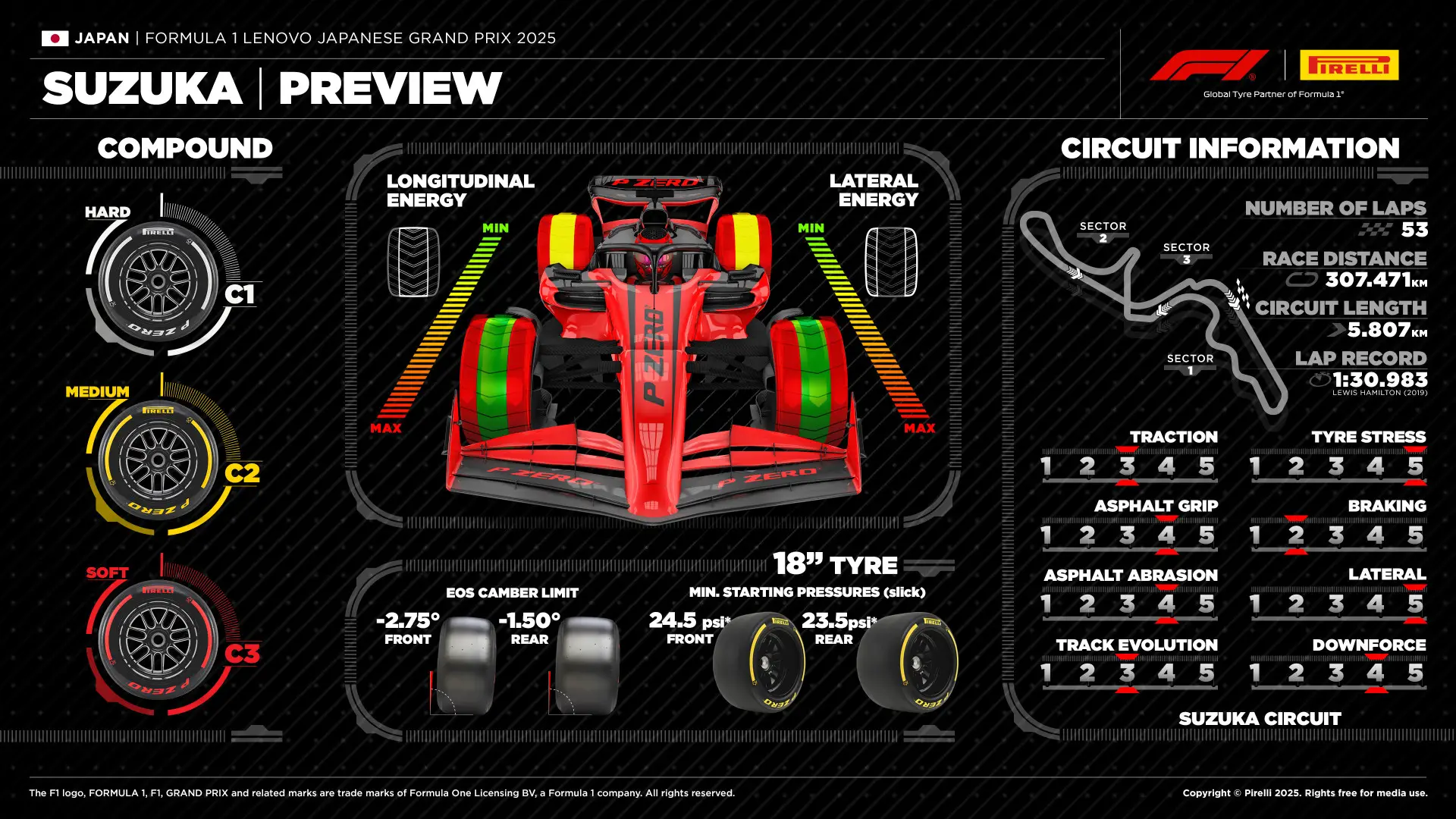
FIND OUT MORE
Free Practice
In FP1, Lando Norris set the early pace at a sun-soaked Suzuka, topping the timesheets ahead of George Russell and Charles Leclerc. All eyes were on home hero Yuki Tsunoda as he made a strong start to life as a Red Bull driver, finishing just behind Max Verstappen in an impressive debut. With rookies Hadjar, Antonelli, and reserve driver Hirakawa also making headlines, the opening session hinted at a thrilling weekend to come in Japan with the top ten all within under a second of each other. Norris topped the timesheets with a time of 1:28.549.
FP2 at Suzuka delivered as much drama as data, with Oscar Piastri emerging on top in a disrupted and incident-packed hour that saw four red flags bring the running to a near-standstill. The session was anything but smooth, with barely 20 minutes of green flag action. Piastri clocked a 1:28.114 to narrowly beat his McLaren teammate and current championship leader, Lando Norris, by just 0.049s in a frantic late-session shootout. Behind the McLarens, the standout of the session was Racing Bulls rookie Isack Hadjar, who briefly held P1 before being displaced and ultimately finished third—another strong showing in what’s turning into a breakout start to his F1 career.
In FP3, despite multiple off-track moments and what appeared to be a challenging balance on his MCL39, Lando Norris pulled together a 1:27.965 to top the timesheets for the second time in the weekend, edging out Piastri by just 0.026s. McLaren’s one-lap dominance in 2025 remained intact, and their back-to-back practice lockouts underscored how well-suited the car was to Suzuka’s high-speed complexity. George Russell continued to be McLaren’s closest challenger, ending the session in third with a time just over a tenth off Norris’s.
Full Free Practice Reports
Free Practice 1 Classification
FP1 was held on 4 April 2025 from 11:30 am to 12:30 pm local time.
Free Practice 2 Classification
FP2 was held on 4 April 2025 from 3:00 pm to 4:00 pm local time.
| Pos | No | Driver | Car | Time | Gap | Laps |
|---|---|---|---|---|---|---|
| 1 | 81 | Oscar Piastri | McLaren Mercedes | 1:28.114 | 13 | |
| 2 | 4 | Lando Norris | McLaren Mercedes | 1:28.163 | +0.049s | 12 |
| 3 | 6 | Isack Hadjar | Racing Bulls Honda RBPT | 1:28.518 | +0.404s | 12 |
| 4 | 44 | Lewis Hamilton | Ferrari | 1:28.544 | +0.430s | 14 |
| 5 | 30 | Liam Lawson | Racing Bulls Honda RBPT | 1:28.559 | +0.445s | 13 |
| 6 | 63 | George Russell | Mercedes | 1:28.567 | +0.453s | 13 |
| 7 | 16 | Charles Leclerc | Ferrari | 1:28.586 | +0.472s | 14 |
| 8 | 1 | Max Verstappen | Red Bull Racing Honda RBPT | 1:28.670 | +0.556s | 9 |
| 9 | 10 | Pierre Gasly | Alpine Renault | 1:28.757 | +0.643s | 13 |
| 10 | 55 | Carlos Sainz | Williams Mercedes | 1:28.832 | +0.718s | 9 |
| 11 | 23 | Alexander Albon | Williams Mercedes | 1:29.023 | +0.909s | 11 |
| 12 | 27 | Nico Hulkenberg | Kick Sauber Ferrari | 1:29.062 | +0.948s | 12 |
| 13 | 5 | Gabriel Bortoleto | Kick Sauber Ferrari | 1:29.335 | +1.221s | 13 |
| 14 | 31 | Esteban Ocon | Haas Ferrari | 1:29.507 | +1.393s | 13 |
| 15 | 87 | Oliver Bearman | Haas Ferrari | 1:29.654 | +1.540s | 10 |
| 16 | 12 | Kimi Antonelli | Mercedes | 1:29.733 | +1.619s | 13 |
| 17 | 14 | Fernando Alonso | Aston Martin Aramco Mercedes | 1:29.978 | +1.864s | 5 |
| 18 | 22 | Yuki Tsunoda | Red Bull Racing Honda RBPT | 1:30.625 | +2.511s | 12 |
| 19 | 18 | Lance Stroll | Aston Martin Aramco Mercedes | 1:30.845 | +2.731s | 12 |
| 20 | 7 | Jack Doohan | Alpine Renault | 1:31.659 | +3.545s | 4 |
Free Practice 3 Classification
FP3 was held on 5 April 2025 from 11:30 am to 12:30 pm local time.
| Pos | No | Driver | Car | Time | Gap | Laps |
|---|---|---|---|---|---|---|
| 1 | 4 | Lando Norris | McLaren Mercedes | 1:27.965 | 17 | |
| 2 | 81 | Oscar Piastri | McLaren Mercedes | 1:27.991 | +0.026s | 17 |
| 3 | 63 | George Russell | Mercedes | 1:28.077 | +0.112s | 15 |
| 4 | 16 | Charles Leclerc | Ferrari | 1:28.414 | +0.449s | 13 |
| 5 | 1 | Max Verstappen | Red Bull Racing Honda RBPT | 1:28.497 | +0.532s | 21 |
| 6 | 44 | Lewis Hamilton | Ferrari | 1:28.524 | +0.559s | 13 |
| 7 | 23 | Alexander Albon | Williams Mercedes | 1:28.554 | +0.589s | 19 |
| 8 | 10 | Pierre Gasly | Alpine Renault | 1:28.603 | +0.638s | 15 |
| 9 | 22 | Yuki Tsunoda | Red Bull Racing Honda RBPT | 1:28.785 | +0.820s | 15 |
| 10 | 6 | Isack Hadjar | Racing Bulls Honda RBPT | 1:28.786 | +0.821s | 16 |
| 11 | 55 | Carlos Sainz | Williams Mercedes | 1:28.846 | +0.881s | 22 |
| 12 | 30 | Liam Lawson | Racing Bulls Honda RBPT | 1:29.104 | +1.139s | 19 |
| 13 | 12 | Kimi Antonelli | Mercedes | 1:29.126 | +1.161s | 20 |
| 14 | 7 | Jack Doohan | Alpine Renault | 1:29.767 | +1.802s | 15 |
| 15 | 14 | Fernando Alonso | Aston Martin Aramco Mercedes | 1:29.772 | +1.807s | 17 |
| 16 | 87 | Oliver Bearman | Haas Ferrari | 1:30.084 | +2.119s | 17 |
| 17 | 5 | Gabriel Bortoleto | Kick Sauber Ferrari | 1:30.134 | +2.169s | 13 |
| 18 | 31 | Esteban Ocon | Haas Ferrari | 1:30.183 | +2.218s | 17 |
| 19 | 18 | Lance Stroll | Aston Martin Aramco Mercedes | 1:30.267 | +2.302s | 16 |
| 20 | 27 | Nico Hulkenberg | Kick Sauber Ferrari | 1:30.621 | +2.656s | 17 |
Qualifying
In a twist worthy of Suzuka’s legendary status, Max Verstappen delivered a lightning bolt of a lap to seize pole position for the 2025 Japanese Grand Prix, pulling off a stunning late charge to deny McLaren a clean sweep in qualifying. The reigning world champion, who had looked a step behind all weekend, threw down a 1:26.983 in the final seconds of Q3 to edge out Lando Norris by just 0.012s, with Oscar Piastri less than half a tenth behind in third. The top three were split by just 0.039s—one of the tightest front-row battles of the 2025 season so far.
Full Qualifying Report
Qualifying Classification
Qualifying was held on 5 April 2025 from 3:00 pm to 4:00 pm local time.
| Pos | No | Driver | Car | Q1 | Q2 | Q3 | Laps |
|---|---|---|---|---|---|---|---|
| 1 | 1 | Max Verstappen | Red Bull Racing Honda RBPT | 1:27.943 | 1:27.502 | 1:26.983 | 17 |
| 2 | 4 | Lando Norris | McLaren Mercedes | 1:27.845 | 1:27.146 | 1:26.995 | 15 |
| 3 | 81 | Oscar Piastri | McLaren Mercedes | 1:27.687 | 1:27.507 | 1:27.027 | 18 |
| 4 | 16 | Charles Leclerc | Ferrari | 1:27.920 | 1:27.555 | 1:27.299 | 21 |
| 5 | 63 | George Russell | Mercedes | 1:27.843 | 1:27.400 | 1:27.318 | 17 |
| 6 | 12 | Kimi Antonelli | Mercedes | 1:27.968 | 1:27.639 | 1:27.555 | 18 |
| 7 | 6 | Isack Hadjar | Racing Bulls Honda RBPT | 1:28.278 | 1:27.775 | 1:27.569 | 18 |
| 8 | 44 | Lewis Hamilton | Ferrari | 1:27.942 | 1:27.610 | 1:27.610 | 23 |
| 9 | 23 | Alexander Albon | Williams Mercedes | 1:28.218 | 1:27.783 | 1:27.615 | 20 |
| 10 | 87 | Oliver Bearman | Haas Ferrari | 1:28.228 | 1:27.711 | 1:27.867 | 21 |
| 11 | 10 | Pierre Gasly | Alpine Renault | 1:28.186 | 1:27.822 | 12 | |
| 12 | 55 | Carlos Sainz | Williams Mercedes | 1:28.209 | 1:27.836 | 15 | |
| 13 | 14 | Fernando Alonso | Aston Martin Aramco Mercedes | 1:28.337 | 1:27.897 | 12 | |
| 14 | 30 | Liam Lawson | Racing Bulls Honda RBPT | 1:28.554 | 1:27.906 | 12 | |
| 15 | 22 | Yuki Tsunoda | Red Bull Racing Honda RBPT | 1:27.967 | 1:28.000 | 12 | |
| 16 | 27 | Nico Hulkenberg | Kick Sauber Ferrari | 1:28.570 | 9 | ||
| 17 | 5 | Gabriel Bortoleto | Kick Sauber Ferrari | 1:28.622 | 9 | ||
| 18 | 31 | Esteban Ocon | Haas Ferrari | 1:28.696 | 9 | ||
| 19 | 7 | Jack Doohan | Alpine Renault | 1:28.877 | 9 | ||
| 20 | 18 | Lance Stroll | Aston Martin Aramco Mercedes | 1:29.271 | 5 | ||
| Note – Sainz penalised three grid places for impeding. | |||||||
2025 Japanese Grand Prix Starting Grid
The Grand Prix starting grid, with or without penalties, after the 2025 Japanese Grand Prix Qualifying session.
| Pos | No | Driver | Car | |
|---|---|---|---|---|
| 1 | 1 | Max Verstappen | Red Bull Racing Honda RBPT | |
| 2 | 4 | Lando Norris | McLaren Mercedes | |
| 3 | 81 | Oscar Piastri | McLaren Mercedes | |
| 4 | 16 | Charles Leclerc | Ferrari | |
| 5 | 63 | George Russell | Mercedes | |
| 6 | 12 | Kimi Antonelli | Mercedes | |
| 7 | 6 | Isack Hadjar | Racing Bulls Honda RBPT | |
| 8 | 44 | Lewis Hamilton | Ferrari | |
| 9 | 23 | Alexander Albon | Williams Mercedes | |
| 10 | 87 | Oliver Bearman | Haas Ferrari | |
| 11 | 10 | Pierre Gasly | Alpine Renault | |
| 12 | 14 | Fernando Alonso | Aston Martin Aramco Mercedes | |
| 13 | 30 | Liam Lawson | Racing Bulls Honda RBPT | |
| 14 | 22 | Yuki Tsunoda | Red Bull Racing Honda RBPT | |
| 15 | 55 | Carlos Sainz | Williams Mercedes | |
| 16 | 27 | Nico Hulkenberg | Kick Sauber Ferrari | |
| 17 | 5 | Gabriel Bortoleto | Kick Sauber Ferrari | |
| 18 | 31 | Esteban Ocon | Haas Ferrari | |
| 19 | 7 | Jack Doohan | Alpine Renault | |
| 20 | 18 | Lance Stroll | Aston Martin Aramco Mercedes | |
| Note – Sainz received a three-place penalty for impeding another driver during Qualifying | ||||
What happened in the 2025 Japanese Grand Prix?
Max Verstappen returned to winning ways in style at the 2025 Japanese Grand Prix, fending off relentless pressure from the McLarens of Lando Norris and Oscar Piastri to claim his first victory of the season and his fourth consecutive triumph at the iconic Suzuka Circuit. After a winless start to the year, the reigning world champion reminded everyone exactly why he remains a title favourite—delivering a flawless performance under intense pressure to reignite his championship campaign.
From pole, Verstappen launched cleanly and quickly settled into rhythm, holding the McLaren duo at bay through the opening stint. But the real flashpoint of the race came on lap 22, when he and Norris pitted simultaneously. A slightly slow stop from Red Bull gave Norris a sniff of opportunity, and the McLaren emerged right alongside the Dutchman at the pit exit. In a dramatic moment, Norris was squeezed onto the grass as Verstappen rejoined just ahead. Both drivers voiced their frustration on the radio, but the stewards deemed it a racing incident—no further action was taken.
That close call didn’t rattle Verstappen. He rebuilt a gap while carefully managing tyre wear, as the two McLarens traded sector times behind him. In the final 10 laps, Piastri surged up to the back of Norris, pressuring his teammate and momentarily threatening a late switch in positions. The internal battle forced Norris to push harder, briefly narrowing the gap to Verstappen, but ultimately, the Red Bull driver held firm to take the chequered flag just 1.4 seconds clear.
It was a vintage Verstappen drive—controlled, precise, and resilient—and a long-awaited one, marking his 64th Grand Prix win and ending a rare drought stretching back to mid-2024.
McLaren, despite missing out on the top step, would take encouragement from another strong double podium. Norris extended his championship lead—albeit narrowly—with a P2 finish, and Piastri marked his 24th birthday with a hard-fought P3, the pair now holding one win apiece alongside Verstappen in the 2025 tally. Charles Leclerc drove a lonely race to finish fourth for Ferrari, unable to match the top three but comfortably clear of the chasing pack.
Mercedes kept things steady, with George Russell finishing fifth and rookie teammate Andrea Kimi Antonelli impressing in sixth after briefly leading during the pit cycle thanks to an extended opening stint. Lewis Hamilton secured seventh in the second Ferrari, having passed Racing Bulls’ Isack Hadjar early on and managed his tyres well through the middle phase of the race.
Hadjar still walked away with his first points of his F1 career, finishing a composed eighth and once again showing maturity well beyond his rookie status. Alex Albon brought Williams more valuable points in ninth, while Ollie Bearman completed the top ten, the young Brit once again delivering for Haas in a quietly consistent start to his F1 career.
Fernando Alonso narrowly missed out in 11th for Aston Martin but at least reached the flag after DNFs in both previous rounds. Yuki Tsunoda, making his Red Bull race debut at home, finished a frustrating 12th—missing out on points but earning the fan-voted Driver of the Day. A tough result for the Japanese star, but not without flashes of promise.
Further back, Pierre Gasly led a struggling Alpine effort in 13th, ahead of Carlos Sainz—who never quite found his rhythm in the Williams—and Jack Doohan, whose difficult weekend continued with a quiet run to 15th. The rest of the field remained in damage-limitation mode: Nico Hulkenberg and Gabriel Bortoleto couldn’t lift the Kick Sauber cars beyond P16 and P19, while Esteban Ocon, Liam Lawson, and Lance Stroll filled out the final positions.
With the win, Verstappen cut Norris’ championship lead to a single point, reigniting what was quickly becoming a thrilling three-way title fight between the Red Bull ace and McLaren’s dynamic duo. Piastri sat just 13 points adrift in third heading into the following weekend’s 2025 Bahrain Grand Prix—where momentum may prove just as important as outright pace in the fast-shifting 2025 season.
2025 Japanese Grand Prix Race Results
The 2025 Japanese Grand Prix Race was held on 6 April 2025 at 2:00 pm local time.
| Pos | No | Driver | Car | Laps | Time/retired | Pts |
|---|---|---|---|---|---|---|
| 1 | 1 | Max Verstappen | Red Bull Racing Honda RBPT | 53 | 1:22:06.983 | 25 |
| 2 | 4 | Lando Norris | McLaren Mercedes | 53 | +1.423s | 18 |
| 3 | 81 | Oscar Piastri | McLaren Mercedes | 53 | +2.129s | 15 |
| 4 | 16 | Charles Leclerc | Ferrari | 53 | +16.097s | 12 |
| 5 | 63 | George Russell | Mercedes | 53 | +17.362s | 10 |
| 6 | 12 | Kimi Antonelli | Mercedes | 53 | +18.671s | 8 |
| 7 | 44 | Lewis Hamilton | Ferrari | 53 | +29.182s | 6 |
| 8 | 6 | Isack Hadjar | Racing Bulls Honda RBPT | 53 | +37.134s | 4 |
| 9 | 23 | Alexander Albon | Williams Mercedes | 53 | +40.367s | 2 |
| 10 | 87 | Oliver Bearman | Haas Ferrari | 53 | +54.529s | 1 |
| 11 | 14 | Fernando Alonso | Aston Martin Aramco Mercedes | 53 | +57.333s | 0 |
| 12 | 22 | Yuki Tsunoda | Red Bull Racing Honda RBPT | 53 | +58.401s | 0 |
| 13 | 10 | Pierre Gasly | Alpine Renault | 53 | +62.122s | 0 |
| 14 | 55 | Carlos Sainz | Williams Mercedes | 53 | +74.129s | 0 |
| 15 | 7 | Jack Doohan | Alpine Renault | 53 | +81.314s | 0 |
| 16 | 27 | Nico Hulkenberg | Kick Sauber Ferrari | 53 | +81.957s | 0 |
| 17 | 30 | Liam Lawson | Racing Bulls Honda RBPT | 53 | +82.734s | 0 |
| 18 | 31 | Esteban Ocon | Haas Ferrari | 53 | +83.438s | 0 |
| 19 | 5 | Gabriel Bortoleto | Kick Sauber Ferrari | 53 | +83.897s | 0 |
| 20 | 18 | Lance Stroll | Aston Martin Aramco Mercedes | 52 | +1 lap | 0 |
2025 Japanese Grand Prix Fastest Laps
| Pos | No | Driver | Car | Lap | Time of day | Time | Avg speed |
|---|---|---|---|---|---|---|---|
| 1 | 12 | Kimi Antonelli | Mercedes | 50 | 15:21:38 | 1:30.965 | 229.815 |
| 2 | 81 | Oscar Piastri | McLaren Mercedes | 53 | 15:25:56 | 1:31.039 | 229.629 |
| 3 | 1 | Max Verstappen | Red Bull Racing Honda RBPT | 52 | 15:24:22 | 1:31.041 | 229.624 |
| 4 | 55 | Carlos Sainz | Williams Mercedes | 36 | 15:01:00 | 1:31.106 | 229.460 |
| 5 | 4 | Lando Norris | McLaren Mercedes | 51 | 15:22:52 | 1:31.116 | 229.435 |
| 6 | 23 | Alexander Albon | Williams Mercedes | 52 | 15:25:03 | 1:31.125 | 229.412 |
| 7 | 6 | Isack Hadjar | Racing Bulls Honda RBPT | 52 | 15:24:59 | 1:31.317 | 228.929 |
| 8 | 63 | George Russell | Mercedes | 51 | 15:23:08 | 1:31.357 | 228.829 |
| 9 | 44 | Lewis Hamilton | Ferrari | 51 | 15:23:19 | 1:31.406 | 228.707 |
| 10 | 16 | Charles Leclerc | Ferrari | 47 | 15:16:59 | 1:31.469 | 228.549 |
| 11 | 14 | Fernando Alonso | Aston Martin Aramco Mercedes | 51 | 15:23:46 | 1:31.770 | 227.799 |
| 12 | 10 | Pierre Gasly | Alpine Renault | 52 | 15:25:22 | 1:31.820 | 227.675 |
| 13 | 22 | Yuki Tsunoda | Red Bull Racing Honda RBPT | 51 | 15:23:48 | 1:31.871 | 227.549 |
| 14 | 31 | Esteban Ocon | Haas Ferrari | 48 | 15:19:33 | 1:31.967 | 227.311 |
| 15 | 87 | Oliver Bearman | Haas Ferrari | 49 | 15:20:39 | 1:32.006 | 227.215 |
| 16 | 5 | Gabriel Bortoleto | Kick Sauber Ferrari | 45 | 15:14:57 | 1:32.034 | 227.146 |
| 17 | 30 | Liam Lawson | Racing Bulls Honda RBPT | 39 | 15:05:39 | 1:32.043 | 227.124 |
| 18 | 18 | Lance Stroll | Aston Martin Aramco Mercedes | 53 | 15:26:06 | 1:32.052 | 227.102 |
| 19 | 27 | Nico Hulkenberg | Kick Sauber Ferrari | 31 | 14:53:08 | 1:32.572 | 225.826 |
| 20 | 7 | Jack Doohan | Alpine Renault | 47 | 15:17:56 | 1:32.685 | 225.551 |
2025 Post-Race F1 Championship Standings
Championship standings for Drivers’ and Teams after the 2025 Japanese Grand Prix.
2025 Post-Race F1 Drivers’ Championship Standings
| Pos | Driver | Nationality | Car | PTS |
|---|---|---|---|---|
| 1 | Lando Norris | GBR | McLaren | 62 |
| 2 | Max Verstappen | NED | Red Bull Racing Honda RBPT | 61 |
| 3 | Oscar Piastri | AUS | McLaren | 49 |
| 4 | George Russell | GBR | Mercedes | 45 |
| 5 | Kimi Antonelli | ITA | Mercedes | 30 |
| 6 | Charles Leclerc | MON | Ferrari | 20 |
| 7 | Alexander Albon | THA | Williams Mercedes | 18 |
| 8 | Lewis Hamilton | GBR | Ferrari | 15 |
| 9 | Esteban Ocon | FRA | Haas Ferrari | 10 |
| 10 | Lance Stroll | CAN | Aston Martin Mercedes | 10 |
| 11 | Nico Hulkenberg | GER | Kick Sauber Ferrari | 6 |
| 12 | Oliver Bearman | GBR | Haas Ferrari | 5 |
| 13 | Isack Hadjar | FRA | Racing Bulls Honda RBPT | 4 |
| 14 | Yuki Tsunoda | JPN | Red Bull Racing Honda RBPT | 3 |
| 15 | Carlos Sainz | ESP | Williams Mercedes | 1 |
| 16 | Pierre Gasly | FRA | Alpine Renualt | 0 |
| 17 | Fernando Alonso | ESP | Aston Martin Mercedes | 0 |
| 18 | Liam Lawson | NZL | Racing Bulls Honda RBPT | 0 |
| 19 | Jack Doohan | AUS | Alpine Renualt | 0 |
| 20 | Gabriel Bortoleto | BRA | Kick Sauber Ferrari | 0 |
2025 Post-Race F1 Constructors’ Championship Standings
Seen in:

